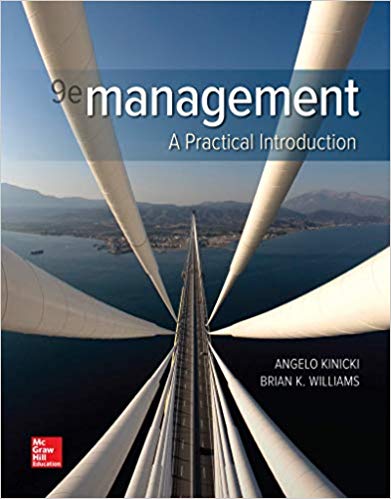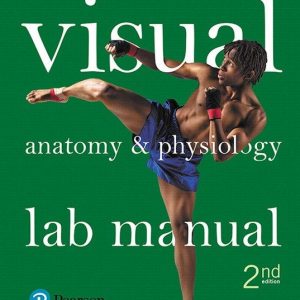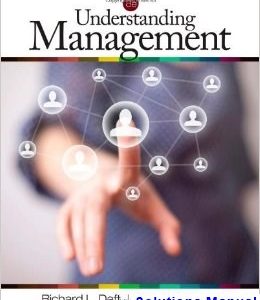Instant download Solution Manual for Management 9th by Kinicki pdf docx epub after payment.

Product details:
- ISBN-10 : 1260075117
- ISBN-13 : 978-1260075113
- Author: Angelo Kinicki;
Table of contents:
A One-Minute Guide to Success in This Class 1 part 1 Introduction 2 chapter 1 The Exceptional Manager: What You Do, How You Do It 2 1.1 Management: What It Is, What Its Benefits Are 4 The Art of Management Defined 4 Why Organizations Value Managers: The Multiplier Effect 6 Financial Rewards of Being a Star Manager 6 Psychological Rewards of Being a Manager 7 1.2 Six Challenges to Being a Star Manager 8 Challenge #1: Managing for Competitive Advantage?Staying Ahead of Rivals 8 Challenge #2: Managing for Diversity?The Future Won?t Resemble the Past 9 Challenge #3: Managing for Globalization?The Expanding Management Universe 10 Challenge #4: Managing for Information Technology 10 Challenge #5: Managing for Ethical Standards 11 Challenge #6: Managing for Your Own Happiness & Life Goals 11 1.3 What Managers Do: The Four Principal Functions 12 Planning: Discussed in Part 3 of This Book 12 Organizing: Discussed in Part 4 of This Book 13 Leading: Discussed in Part 5 of This Book 13 Controlling: Discussed in Part 6 of This Book 13 1.4 Pyramid Power: Levels & Areas of Management 14 The Traditional Management Pyramid: Levels & Areas 14 Three Levels of Management 14 Areas of Management: Functional Managers versus General Managers 16 Managers for Three Types of Organizations: For-Profit, Nonprofit, Mutual- Benefit 17 1.5 Roles Managers Must Play Successfully 18 The Manager?s Roles: Mintzberg?s Useful Findings 18 Three Types of Managerial Roles 20 1.6 The Skills Star Managers Need 22 Technical Skills?The Ability to Perform a Specific Job 22 Conceptual Skills?The Ability to Think Analytically 22 Human Skills?The Ability to Interact Well with People 22 Learning Portfolio 24 Taking Something Practical Away from This Chapter: Getting Control of Your Time?Dealing with the Information Deluge in College & in Your Career 24, Key Terms Used in This Chapter 27, Summary 27, Management in Action 28, Self- Assessment 29, Group Exercise 30, Ethical Dilemma 30, Video Case 31 chapter 2 Management Theory: Essential Background for The Successful Manager 32 2.1 Evolving Viewpoints: How We Got to Today?s Management Outlook 34 Is Management an Art or a Science? 34 Two Overarching Perspectives about Management & Four Practical Reasons for Studying Them 34 2.2 Classical Viewpoint: Scientific & Administrative Management 36 Scientific Management: Pioneered by Taylor & the Gilbreths 37 Administrative Management: Pioneered by Fayol & Weber 38 The Problem with the Classical Viewpoint: Too Mechanistic 39 2.3 Behavioral Viewpoint: Behaviorism, Human Relations, & Behavioral Science 40 The Early Behaviorists: Pioneered by Munsterberg, Follett, & Mayo 40 The Human Relations Movement: Pioneered by Maslow & McGregor 42 The Behavioral Science Approach 43 2.4 Quantitative Viewpoints: Management Science & Operations Management 44 Management Science: Using Mathematics to Solve Management Problems 44 Operations Management: Helping Organizations Deliver Products or Services More Effectively 45 2.5 Systems Viewpoint 46 The Systems Viewpoint 46 The Four Parts of a System 46 2.6 Contingency Viewpoint 50 2.7 Quality-Management Viewpoint 52 Quality Control & Quality Assurance 52 Total Quality Management: Creating an Organization Dedicated to Continuous Improvement 53 2.8 The Learning Organization 54 The Learning Organization: Handling Knowledge & Modifying Behavior 54 How to Build a Learning Organization: Three Roles Managers Play 54 Learning Portfolio 56 Key Terms Used in This Chapter 56, Summary 56, Management in Action 58, Self-Assessment 60, Group Exercise 61, Ethical Dilemma 62, Video Case 63 part 2 The Environment of Management 64 chapter 3 The Manager?s Changing Work Environment & Responsibilities 64 3.1 The Community of Stakeholders Inside the Organization 66 Internal & External Stakeholders 67 Internal Stakeholders 67 3.2 The Community of Stakeholders Outside the Organization 70 The Task Environment 70 The General Environment 74 3.3 The Ethical Responsibilities Required of You as a Manager 76 Defining Ethics & Values 76 Four Approaches to Deciding Ethical Dilemmas 77 How Organizations Can Promote Ethics 78 3.4 The Social Responsibilities Required of You as a Manager 80 Is Social Responsibility Worthwhile? Opposing & Supporting Viewpoints 81 Four Managerial Approaches to Social Responsibility 82 Bottom Line: Does Being Good Pay Off Financially? 83 3.5 The New Diversified Workforce 84 How to Think about Diversity: Which Differences Are Important? 84 Trends in Workforce Diversity 86 Barriers to Diversity 88 3.6 The Entrepreneurial Spirit 90 Entrepreneurship Defined: Taking Risks in Pursuit of Opportunity 90 Learning Portfolio 94 Key Terms Used in This Chapter 94, Summary 94, Management in Action 96, Self-Assessment 97, Group Exercise 98, Ethical Dilemma 99, Video Case 99 chapter 4 Global Management: Managing Across Borders 100 4.1 Globalization: The Collapse of Time & Distance 102 The Rise of the ?Global Village? & Electronic Commerce 102 One Big World Market: The Global Economy 103 Cross-Border Business: The Rise of Both Megamergers & Minifirms Worldwide 104 4.2 You & International Management 110 Why Learn About International Management? 106 The Successful International Manager: Geocentric, Not Ethnocentric or Polycentric 106 4.3 Why & How Companies Expand Internationally 110 Why Companies Expand Internationally 110 How Companies Expand Internationally 112 4.4 Economic & Political-Legal Differences 116 Economic Differences: Adjusting to Other Countries? Economies 116 Political-Legal Differences: Adjusting to Other Countries? Governments & Laws 118 4.5 The World of Free Trade: Regional Economic Cooperation 120 Barriers to International Trade 120 Organizations Promoting International Trade 121 Major Trading Blocs: NAFTA, EU, ASEAN, & Mercosur 122 Most Favored Nation Trading Status 123 4.6 The Importance of Understanding Cultural Differences 124 The Importance of National Culture 124 What Are Different Cultural Perceptions of Language, Nonverbal Communication, Time Orientation, & Religion? 125 LEARNING PORTFOLIO 130 Key Terms Used in This Chapter 130, Summary 130, Management in Action 132, Self-Assessment 134, Group Exercise 135, Ethical Dilemma 136, Video Case 137 part 3 Planning 138 chapter 5 Planning: The Foundation of Successful Management 138 5.1 Planning & Uncertainty 140 Why Not Plan? 140 How Planning Helps You: Four Benefits 141 Three Types of Uncertainty: State, Effect, & Response 142 How Organizations Respond to Uncertainty 143 5.2 Fundamentals of Planning 144 Mission & Vision Statements 145 Three Types of Planning for Three Levels of Management: Strategic, Tactical, & Operational 146 Goals & Action Plans 147 Setting SMART Goals 148 5.3 The Planning/Control Cycle 150 5.4 Promoting Goal Setting: Management by Objectives 152 What Is MBO? The Four-Step Process for Motivating Employees 152 Cascading Objectives: MBO from the Top Down 153 5.5 Project Planning 154 Why Project Planning Is Important Today 154 The Project Life Cycle: The Predictable Evolution of a Project 156 The Importance of Project Deadlines 158 LEARNING PORTFOLIO 160 Key Terms Used in This Chapter 160, Summary 160, Management in Action 161, Self-Assessment 162, Group Exercise 164, Ethical Dilemma 165, Video Case 165 chapter 6 Strategic Management: How Star Managers Realize a Grand Design 168 6.1 The Dynamics of Strategic Planning 170 Strategy, Strategic Management, & Strategic Planning: What They Are, Why They?re Important 171 Why Strategic Management & Strategic Planning Are Important 171 Does Strategic Management Work for Small as Well as Large Firms? 173 6.2 The Strategic Management Process 174 The Five Steps of the Strategic Management Process 175 6.3 Establishing the Grand Strategy 180 SWOT Analysis 180 Forecasting: Predicting the Future 182 6.4 Formulating Strategy 184 Porter?s Four Competitive Strategies 184 The Product Life Cycle: Different Stages Require Different Strategies 186 Single Product Strategy versus Diversification Strategy 188 Competitive Intelligence 189 6.5 Carrying Out & Controlling Strategy 190 The Balanced Scorecard 190 Measurement Management 192 The Feedback Loop 193 Learning Portfolio 194 Key Terms Used in This Chapter 194, Summary 194, Management in Action 195, Self-Assessment 197, Group Exercise 198, Ethical Dilemma 199, Video Case 199 chapter 7 Individual & Group Decision Making: How Managers Make Things Happen 202 7.1 The Nature of Decision Making 204 Decision Making Defined 204 Types of Decisions: Programmed versus Nonprogrammed 205 General Decision-Making Styles: Directive, Analytical, Conceptual, Behavioral 206 7.2 Two Kinds of Decision Making: Rational & Nonrational 208 Rational Decision Making: Managers Should Make Logical & Optimum Decisions 208 Stage 1: Identify the Problem or Opportunity?Determining the Actual versus the Desirable 209 Stage 2: Think Up Alternative Solutions?Both the Obvious & the Creative 209 Stage 3: Evaluate Alternatives & Select a Solution?Ethics, Feasibility, & Effectiveness 209 Stage 4: Implement & Evaluate the Solution Chosen 210 What?s Wrong with the Rational Model? 211 Nonrational Decision Making: Managers Find It Difficult to Make Optimum Decisions 212 Making Better Decisions through Knowledge Management 213 7.3 Making Ethical Decisions 214 Road Map to Ethical Decision Making: A Decision Tree 214 Applying the Ethical Decision Tree 215 General Moral Principles for Managers 216 7.4 Group Decision Making: How to Work with Others 218 Advantages & Disadvantages of Group Decision Making 218 What Managers Need to Know About Groups & Decision Making 219 Participative Management: Involving Employees in Decision Making 220 Group Problem-Solving Techniques: Reaching for Consensus 221 More Group Problem-Solving Techniques 222 7.5 How to Overcome Barriers to Decision Making 224 How Do Individuals Respond to a Decision Situation? Ineffective & Effective Responses 224 Four Common Decision-Making Biases: Rules of Thumb or ?Heuristics? 226 LEARNING PORTFOLIO 230 Key Terms Used in This Chapter 230, Summary 230, Management in Action 232, Self-Assessment 233, Group Exercise 234, Ethical Dilemma 235, Video Case 236 part 4 Organizing 238 chapter 8 Organizational Culture, Structure, & Design: Building Blocks of the Organization 238 8.1 What Kind of Organizational Culture Will You Be Operating In? 240 What Is an Organizational Culture? 240 The Two Levels of Culture: Invisible & Visible 241 The Importance of Culture 242 8.2 What Is an Organization? 244 The Organization: Three Types 244 The Organization Chart 246 8.3 The Major Elements of an Organization 248 Common Elements of an Organization: Four Proposed by Edgar Schein 248 Common Elements of Organizations: Three More That Most Authorities Agree On 249 8.4 Basic Types of Organizational Structures 252 The Simple Structure: For the Small Firm 252 The Functional Structure: Grouping by Similar Work Specialties 252 The Divisional Structure: Grouping by Similarity of Purpose 254 The Conglomerate Structure: Grouping by Industry 255 The Hybrid Structure: Functional & Divisional Used within the Same Organization 256 The Matrix Structure: A Grid of Functional & Divisional for Two Chains of Command 256 The Team-Based Structure: Eliminating Functional Barriers to Solve Problems 257 The Network Structure: Connecting a Central Core to Outside Firms by Computer Connections 259 8.5 Contingency Design: Factors in Creating the Best Structure 260 The Environment: Mechanistic versus Organic Organizations?the Burns & Stalker Model 260 The Environment: Differentiation versus Integration?the Lawrence & Lorsch Model 262 Size: The Larger the Organization, the More Mechanistic 263 Technology: Small-Batch, Large-Batch, or Continuous-Process?Woodward?s Model 263 Life Cycle: Four Stages in the Life of an Organization 264 8.6 Toward Building a Learning Organization 266 Why Organizations Might Resist Learning 266 The New Paradigm: ?We?re All Stakeholders? 267 Learning Portfolio 268 Key Terms Used in This Chapter 268, Summary 268, Management in Action 270, Self-Assessment 271, Group Exercise 272, Ethical Dilemma 273, Video Case 274 chapter 9 Human Resource Management: Getting the Right People for Managerial Success 276 9.1 Strategic Human Resource Management 278 Human Resource Management: Managing an Organization?s Most Important Resource 278 Planning the Human Resources Needed 279 9.2 The Legal Requirements of Human Resource Management 282 Labor Relations 282 Compensation & Benefits 282 Health & Safety 282 Equal Employment Opportunity 282 9.3 Recruitment & Selection: Putting the Right People into the Right Jobs 284 Recruitment: How to Attract Qualified Applicants 284 Selection: How to Choose the Best Person for the Job 286 9.4 Orientation, Training, & Development 290 Orientation: Helping Newcomers Learn the Ropes 290 Training & Development: Helping People Perform Better 291 9.5 Performance Appraisal 294 Defining Performance Appraisal 294 Who Should Make Performance Appraisals? 295 Effective Performance Feedback 297 9.6 Managing an Effective Workforce: Compensation & Benefits 298 Wages or Salaries 298 Incentives 298 Benefits 298 9.7 Other Concerns in Managing an Effective Workforce 300 Managing Promotions, Transfers, Disciplining, & Dismissals 300 Maintaining Effective Relationships with Employees 302 Learning Portfolio 304 Key Terms Used in This Chapter 304, Summary 304, Management in Action 306, Self-Assessment 307, Group Exercise 309, Ethical Dilemma 310, Video Case 311 chapter 10 Organizational Change & Innovation: Life-Long Challenges for the Exceptional Manager 314 10.1 The Nature of Change in Organizations 316 Fundamental Change: What Will You Be Called Upon to Deal With? 316 Two Types of Change: Reactive versus Proactive 316 The Forces for Change: Outside & Inside the Organization 318 Areas in Which Change Is Often Needed: People, Technology, Structure, & Strategy 320 10.2 The Threat of Change: Managing Employee Fear & Resistance 322 The Degree to Which Employees Fear Change: From Least Threatening to Most Threatening 322 Lewin?s Change Model: Unfreezing, Changing, & Refreezing 323 Kotter?s Eight Steps for Leading Organizational Change 324 10.3 Organization Development: What It Is, What It Can Do 326 What Can OD Be Used For? 326 Characteristics of OD 327 How OD Works 327 The Effectiveness of OD 328 10.4 Promoting Innovation within the Organization 330 Types of Innovation: Product or Process, Incremental or Radical 330 Four Characteristics of Innovation 331 Celebrating Failure: Cultural & Other Factors Encouraging Innovation 332 How You Can Foster Innovation: Three Steps 334 Learning Portfolio 336 Key Terms Used in This Chapter 336, Summary 336, Management in Action 337, Self-Assessment 338, Group Exercise 339, Ethical Dilemma 341, Video Case 341 part 5 Leading 344 chapter 11 Managing Individual Differences & Behavior 344 11.1 Values, Attitudes, & Behavior 346 Organizational Behavior: Trying to Explain & Predict Workplace Behavior 346 Values: What Are Your Consistent Beliefs & Feelings about All Things? 346 Attitudes: What Are Your Consistent Beliefs & Feelings about Specific Things? 347 Behavior: How Values & Attitudes Affect People?s Actions & Judgments 349 11.2 Work-Related Attitudes & Behaviors Managers Need to Deal With 350 Work-Related Attitudes: Job Satisfaction, Job Involvement, & Organizational Commitment 350 Important Workplace Behaviors 351 11.3 Personality & Individual Behavior 352 The Big Five Personality Dimensions 352 Four Traits Important in Organizations 353 11.4 Perception & Individual Behavior 356 The Four Steps in the Perceptual Process 356 Three Distortions in Perception 356 The Self-Fulfilling Prophecy, or Pygmalion Effect 359 Causal Attributions 360 11.5 Understanding Stress & Individual Behavior 362 What Is Stress? 362 The Sources of Job-Related Stress: Individual Tasks & Roles, Groups, Organizations, & Nonwork Factors 363 The Consequences of Stress 364 Reducing Stressors in the Organization 365 Learning Portfolio 366 Key Terms Used in This Chapter 366, Summary 366, Management in Action 368, Self-Assessment 369, Group Exercise 370, Ethical Dilemma 371, Video Case 372 chapter 12 Motivating Employees: Achieving Superior Performance in the Workplace 374 12.1 Motivating for Performance 376 Motivation: What It Is, Why It?s Important 376 The Three Major Perspectives on Motivation: Overview 377 12.2 Need-Based Perspectives on Employee Motivation 378 Maslow?s Hierarchy of Needs Theory: Five Levels 378 Herzberg?s Two-Factor Theory: From Dissatisfying Factors to Satisfying Factors 380 McClelland?s Acquired Needs Theory: Achievement, Affiliation, & Power 382 12.3 Process Perspectives on Employee Motivation 384 Expectancy Theory: How Much Do You Want & How Likely Are You to Get It? 384 Equity Theory: How Fairly Do You Think You?re Being Treated in Relation to Others? 387 Goal-Setting Theory: Objectives Should Be Specific & Challenging but Achievable 389 12.4 Reinforcement Perspectives on Motivation 390 The Four Types of Reinforcement: Positive, Negative, Extinction, & Punishment 390 Using Reinforcement to Motivate Employees 392 12.5 Motivation Through Job Design 394 Fitting Jobs to People 394 The Job Characteristics Model: Five Job Attributes for Better Work Outcomes 395 12.6 Using Compensation & Other Rewards to Motivate 398 Motivation & Compensation 398 Nonmonetary Ways of Motivating Employees 399 LEARNING PORTFOLIO 402 Key Terms Used in This Chapter 402, Summary 402, Management in Action 404, Self-Assessment 405, Group Exercise 406, Ethical Dilemma 407, Video Case 408 chapter 13 Groups & Teams: From Conflict to Cooperation 410 13.1 Managing Conflict 412 The Nature of Conflict: Disagreement Is Normal 412 Can Too Little or Too Much Conflict Affect Performance? 413 Seven Causes of Conflict 414 How to Stimulate Constructive Conflict 416 13.2 Teamwork: Cornerstone of Progressive Management 418 More Teamwork: The Change Today?s Employees Need to Make 418 Why Teamwork Matters 419 13.3 Groups versus Teams 420 Groups & Teams: How Do They Differ? 420 Formal versus Informal Groups 421 Work Teams for Four Purposes: Advice, Production, Project, & Action 421 Two Types of Teams in Action: Quality Circles Compared with Self-Managed Teams 422 13.4 Stages of Group & Team Development 426 Stage 1: Forming??Why Are We Here?? 426 Stage 2: Storming??Why Are We Fighting Over Who Does What & Who?s in Charge?? 426 Stage 3: Norming??Can We Agree on Roles & Work as a Team?? 427 Stage 4: Performing??Can We Do the Job Properly?? 427 Stage 5: Adjourning??Can We Help Members Transition Out?? 427 13.5 Building Effective Teams 428 Performance Goals & Feedback 428 Motivation through Mutual Accountability 429 Size: Small Teams or Large Teams? 429 Roles: How Team Members Are Expected to Behave 430 Norms: Unwritten Rules for Team Members 431 Cohesiveness: The Importance of Togetherness 432 Groupthink: When Peer Pressure Discourages ?Thinking Outside the Box? 433 LEARNING PORTFOLIO 436 Key Terms Used in This Chapter 436, Summary 436, Management in Action 437, Self-Assessment 438, Group Exercise 440, Ethical Dilemma 441, Video Case 441 chapter 14 Power, Influence, & Leadership: From Becoming a Manager to Becoming a Leader 442 14.1 The Nature of Leadership: Wielding Influence 444 Managers & Leaders: Not Always the Same 444 Five Sources of Power 445 Leadership & Influence: Using Persuasion to Get Your Way at Work 446 Five Approaches to Leadership 448 14.2 Trait Approaches: Do Leaders Have Distinctive Personality Characteristics? 450 Three Trait Perspectives: Kouzes & Posner, Brossidy, & Goleman 450 Judge?s Research: Is Personality More Important Than Intelligence in Leadership? 452 Gender Studies: Do Women Have Traits That Make Them Better Leaders? 452 14.3 Behavioral Approaches: Do Leaders Show Distinctive Patterns of Behavior? 454 The University of Michigan Leadership Model & the Ohio State Leadership Model 454 Blake & Mouton?s Managerial/Leadership Grid Model: Concern for Both Production & People 455 14.4 Contingency Approaches: Does Leadership Vary with the Situation? 458 The Contingency Leadership Model: Fiedler?s Approach 458 The Path?Goal Leadership Model: House?s Approach 459 The Situational Leadership Model: Hersey & Blanchard?s Approach 462 14.5 The Full-Range Approach: Uses of Transactional & Transformational Leadership 464 Transactional versus Transformational Leaders 464 The Best Leaders Are Both Transactional & Transformational 465 Implications of Transformational Leadership for Managers 466 14.6 Five Additional Perspectives 468 Shared Leadership 468 Servant Leadership: Meeting the Goals of Followers & Organization, Not of Oneself 468 Leading for Loyalty: Six Principles for Generating Faithful Employees, Customers, & Investors 469 Level 5 Leadership 471 E-Leadership: Managing for Global Networks 472 LEARNING PORTFOLIO 474 Key Terms Used in This Chapter 474, Summary 474, Management in Action 476, Self-Assessment 478, Group Exercise 479, Ethical Dilemma 481, Video Case 481 chapter 15 Interpersonal & Organizational Communication 482 15.1 The Communication Process: What It Is, How It Works 484 Communication Defined: The Transfer of Information & Understanding 484 How the Communication Process Works 485 Selecting the Right Medium for Effective Communication 486 15.2 Barriers to Communication 488 Physical Barriers: Sound, Time, Space, & So On 489 Semantic Barriers: When Words Matter 489 Personal Barriers: Individual Attributes That Hinder Communication 491 Nonverbal Communication 492 Gender-Related Communication Differences 493 15.3 How Managers Fit into the Communication Process 496 Formal Communication Channels: Up, Down, Sideways, & Outward 496 Informal Communication Channels 498 15.4 Communication in the Information Age 500 Communications Tools of Information Technology: Offspring of the Internet 500 Dealing with Information Overload 503 15.5 Improving Communication Effectiveness 504 Being an Effective Listener 504 Being an Effective Reader 505 Being an Effective Writer 507 Being an Effective Speaker 508 Learning Portfolio 510 Key Terms Used in This Chapter 510, Summary 510, Management in Action 511, Self-Assessment 512, Group Exercise 515, Ethical Dilemma 516, Video Case 517 part 6 Control 518 chapter 16 Control: Techniques for Enhancing Organizational Effectiveness 518 16.1 Managing for Productivity 520 What Is Productivity? 520 Why Increasing Productivity Is Important 521 16.2 Control: When Managers Monitor Performance 522 Why Is Control Needed? 522 Steps in the Control Process 524 Types of Control: Feedforward, Concurrent, & Feedback 526 16.3 Levels, Areas, & Styles of Control 528 Levels of Control: Strategic, Tactical, & Operational 528 Areas of Control: Physical, Human, Informational, & Financial 529 Styles of Implementing Controls: Bureaucratic, Market, & Clan 530 16.4 Some Financial Tools for Control 532 Budgets: Formal Financial Projections 532 Financial Statements: Summarizing the Organization?s Financial Status 534 Ratio Analysis: Indicators of an Organization?s Financial Health 534 Audits: External versus Internal 534 16.5 Total Quality Management 536 Core TQM Principles: Deliver Customer Value & Strive for Continuous Improvement 536 Some TQM Techniques 538 16.6 Managing Control Effectively 542 The Keys to Successful Control 542 Barriers to Control Success 543 Finale: Some Life Lessons 545 LEARNING PORTFOLIO 546 Key Terms Used in This Chapter 546, Summary 546, Management in Action 548, Self-Assessment 549, Group Exercise 550, Ethical Dilemma 551, Video Case 552 Appendix The Project Planner?s Toolkit: Flowcharts, Gantt Charts, & Break-Even Analysis A 1 Tool #1: Flowcharts?for Showing Event Sequences & Alternate Decision Scenarios A2 Tool #1: Gantt Charts?Visual Time Schedules for Work Tasks A4 Tool #3: Break-Even Analysis?How Many Items Should You Sell to Turn a Profit? A6 Chapter Notes CN1 Glossary G1 Credits CR1 Name Index I1 Company & Organization Index I5 Subject Index I9
People also search:
Management 9th edition
Management 9th edition pdf
Management
supply chain management
human resource management
|
management and program analyst |





